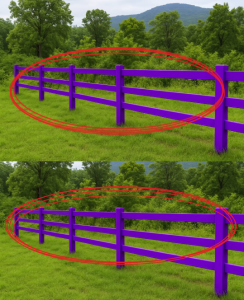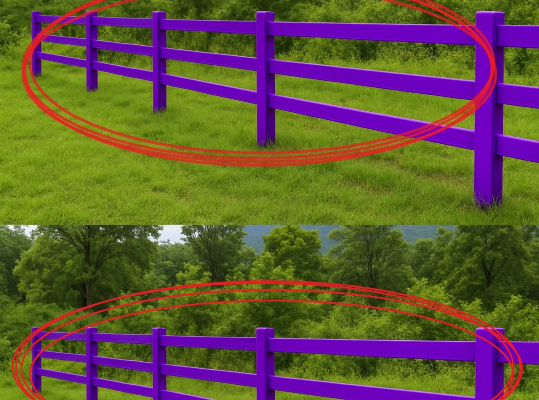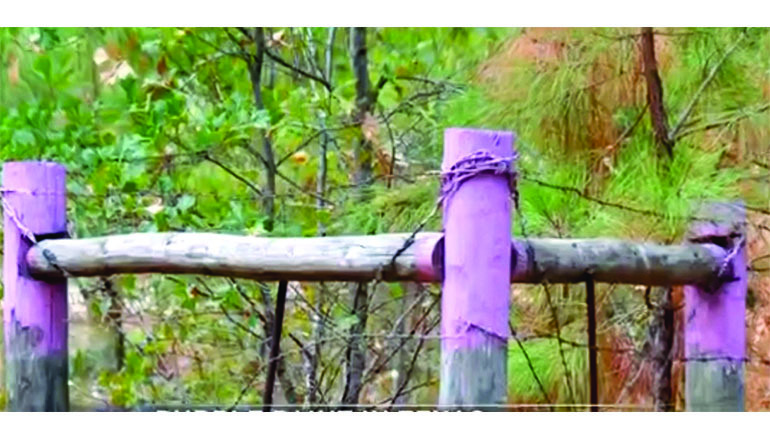Imagine you’re walking or driving through the countryside and suddenly notice a fence, post, or even a tree with a bright streak of purple paint on it. At first, it might seem decorative — maybe the owner just liked the color. But that splash of purple is far from random. In many U.S. states, this painted mark carries a very specific and legally enforceable message:
👉 No Trespassing.
Yes, that’s right — a purple fence is not just a stylistic choice. It’s a legal boundary marker that can carry the same weight as an official “No Trespassing” sign.
🟣 The Meaning Behind the Purple Paint
In several U.S. states, property owners can use purple paint to mark their land boundaries instead of—or in addition to—posting physical “No Trespassing” signs. The paint signals to anyone approaching that the land is private property and entering without permission is illegal.
This practice is rooted in what’s known as the “Purple Paint Law.” It allows property owners to save money, time, and hassle while still giving a clear and legally valid warning to potential trespassers.
🧭 Why Purple Paint Instead of Signs?
There are several practical reasons why purple paint became such a popular option:
-
Durability:
Signs can fade, fall down, or be stolen. Paint, on the other hand, is much harder to remove and lasts much longer. -
Cost-Effective:
Painting posts or trees costs far less than buying and maintaining multiple metal or plastic “No Trespassing” signs. -
Weather Resistant:
Harsh weather can tear down signs, but paint stands strong against wind, rain, and snow. -
Legal Clarity:
In states with Purple Paint Laws, the presence of these marks is legally recognized as a clear warning to stay out.
This makes purple paint especially popular in rural areas, farms, ranches, and wooded properties, where installing and maintaining traditional signs across large stretches of land would be time-consuming and expensive.
📜 Where the Purple Paint Law Exists
The Purple Paint Law first gained traction in the 1990s and has since spread to many states. Some of the states that officially recognize it include:
-
Texas
-
North Carolina
-
Illinois
-
Missouri
-
Kansas
-
Florida
-
Maine
-
Montana
-
Idaho
-
Pennsylvania (recently adopted in some areas)
Each state has its own specific regulations on how and where the paint must be applied for it to count as a legal “No Trespassing” marker.
🖌️ How the Markings Work
The laws typically require purple paint to be applied in a very specific way to ensure the warning is clear:
-
Height:
Usually between 3 to 5 feet above the ground — visible at eye level. -
Width & Length:
Often required to be a vertical stripe at least 8 inches long and 1 inch wide. -
Spacing:
Marks must be placed at regular intervals — often 50 to 100 feet apart — along the property boundary. -
Visibility:
The paint must be easily visible to anyone approaching the property, not hidden behind bushes or placed in an inconspicuous spot.
If these requirements are met, the paint mark carries the same legal force as a posted sign saying “No Trespassing.”
⚖️ Legal Consequences of Ignoring the Purple Fence
In states where the law applies, ignoring a purple-painted fence or boundary is legally considered trespassing — even if there’s no physical sign.
Consequences can include:
-
Warnings or fines: For first-time or minor violations.
-
Misdemeanor charges: For knowingly entering private property without permission.
-
Felony charges: If additional crimes (such as hunting without permission or vandalism) occur during the trespass.
Law enforcement and game wardens are trained to recognize purple markings as a valid legal warning. Claiming “I didn’t see a sign” doesn’t hold up if the purple paint was clearly visible.
🏡 Why Landowners Prefer Purple Paint
For many landowners, the purple paint law has been a game-changer.
-
Farmers and ranchers can protect their land without constantly replacing signs.
-
Hunters and hikers have a clear, unmistakable signal about where they are not allowed.
-
Rural communities can reduce property line disputes and unwanted visitors.
This is especially useful for people who own large, forested, or undeveloped properties. Covering miles of boundary with traditional signage would be expensive, but a few cans of paint and some time can get the job done effectively.
🦌 What It Means for Hunters and Hikers
Hunters, hikers, and outdoor explorers need to be especially aware of purple paint.
-
If you see it, do not enter unless you have explicit permission from the landowner.
-
Even if there’s no gate or fence, the paint is the warning.
-
“I didn’t know” is not an excuse under the law.
Many hunting safety courses in states with Purple Paint Laws specifically teach this rule so that sportsmen can avoid legal trouble.
🌳 Other Colors and Their Meanings
While purple is the most recognized “No Trespassing” color in the U.S., different colors can mean different things in other contexts:
-
Purple: No trespassing / private property
-
Orange: Often used to mark hunting boundaries in some states
-
Blue: In some regions, can indicate waterway or trail boundaries (not legal trespass warnings)
-
Red: Traditionally used in certain private land signs, though not legally standardized like purple
However, only purple has widespread legal backing as an alternative to no trespassing signs in many U.S. states.
🚫 Common Misconceptions
-
❌ “It’s just decoration.”
No — in states with the law, it’s an official legal warning. -
❌ “If there’s no sign, I can go in.”
Wrong — purple paint is the sign. -
❌ “I didn’t know the law.”
Lack of knowledge is not a legal defense. -
❌ “It only applies to hunters.”
No — it applies to anyone entering private property without permission.
📝 What to Do If You See a Purple Fence
-
Stop immediately.
Even if it looks like open land, the paint is a boundary. -
Turn around.
Respect the property owner’s rights. -
Get permission if necessary.
If you need to cross or enter for any reason, obtain clear, verbal or written consent. -
Be aware of state laws.
If you live near rural or farming areas, knowing this rule can keep you out of legal trouble.
🌟 A Simple Color with a Strong Message
What may look like just a purple streak on a fence post actually represents a powerful legal tool that protects property rights, prevents disputes, and provides a clear message to the public.
It’s a silent but firm warning:
“This land is private. Do not enter without permission.”
So the next time you see a painted purple fence, post, or tree, don’t brush it off as a quirky decoration. It’s a legally recognized sign to turn around and respect the boundary.




